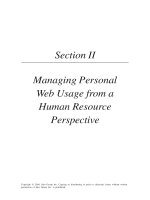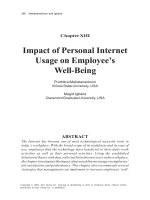coaching a guide for the human resource professional phần 9 doc
Bạn đang xem bản rút gọn của tài liệu. Xem và tải ngay bản đầy đủ của tài liệu tại đây (90.78 KB, 23 trang )
Sample Progress Report
173
Executive Coaching. Copyright © 2005 by John Wiley & Sons, Inc. Reproduced by
permission of Pfeiffer, an Imprint of Wiley. www.pfeiffer.com
Project Objectives
The focus of the project is executive coaching with [name and title
of client]. Coaching objectives for [name of client] include enabling
him/her to:
• Develop leadership skills for current and future
assignments in [Company X]
• Develop specific leadership competencies in accor-
dance with his/her competency survey feedback
• Broaden his/her repertoire of managerial styles
Progress to Date
The coaching objectives that have been targeted thus far have
been to:
• Improve public speaking skills to large audiences of
more than 300 people
174 EXECUTIVE COACHING
Formulate and communicate the business strategy to
his/her organization
• Broaden his/her repertoire of managerial styles, particu-
larly a coaching style that encourages the long-term
development of direct reports
Milestones/Feedback on Public Speaking Skills
On [date], [client] delivered a presentation to 300 people in
which he/she explained the vision and strategy for the organiza-
tion. Feedback from peers and direct reports in the audience was
highly favorable regarding the clarity of the message. Performance
could have been improved by demonstrating greater ease and
facility with theQ&Aportion of the presentation
Feedback on Coaching Style
In the past two quarters, [client] has held quarterly one-on-one
sessions with all direct reports for the purpose of discussing their
professional long-term development goals.
Two staff members have received promotions, and one has
moved laterally to broaden her skills.
Continuing coaching efforts will focus on development of other
leadership competencies such as:
• Improving peer group teamwork
• Delegating responsibility clearly
The coaching is proceeding on schedule, and the client demon-
strates motivation and a willingness to try out new skills and
behaviors.
Coach: Date:
Executive Coaching. Copyright © 2005 by John Wiley & Sons, Inc. Reproduced by
permission of Pfeiffer, an Imprint of Wiley. www.pfeiffer.com
“To-Do” List for Managing
Coaching Resources
175
Action Questions to Ask Yourself
1. Clarify your strategy.
2. Connect coaching to
other development
efforts.
3. Develop a pool of
coaches.
4. Be an effective
gatekeeper.
• What is the purpose of the
coaching?
• How does it link to the business
strategy?
• How does the coaching reinforce
lessons learned in training?
• How can the coaching be used to
enhance on-job experiences?
• What are the skills and abilities
needed in a coach for your organi-
zation? For this client?
• What are the criteria to deter-
mine whether coaching is needed
or not?
Executive Coaching. Copyright © 2005 by John Wiley & Sons, Inc. Reproduced by
permission of Pfeiffer, an Imprint of Wiley. www.pfeiffer.com
176 EXECUTIVE COACHING
Action Questions to Ask Yourself
5. Monitor the PR.
6. Support the execu-
tive as the primary
client.
7. Provide orientations
to the organization.
• What other organization
development efforts might occur
simultaneously?
• What can I do to help the
organization realize the value
of coaching as a methodology?
• How can I help the other stake-
holders understand that the exec-
utive is the primary client?
• How can I help the coach under-
stand the organization’s strategic
business plans and the role that
the client plays in those plans?
• What are the key informal rela-
tionships about which the coach
needs to know in order for the
coaching to be effective?
Executive Coaching. Copyright © 2005 by John Wiley & Sons, Inc. Reproduced by
permission of Pfeiffer, an Imprint of Wiley. www.pfeiffer.com
Appendix
This Appendix contains an Executive Breakaway Section, which is
also posted on the Pfeiffer website (www.pfeiffer.com), intended
to be used as informational reading for coaching clients. It may be
photocopied or printed from the website and distributed to clients.
It contains a summarized version of the key content of this book
presented from the client’s point of view.
177
T
he purpose of this section is to provide you, the coaching client,
with a better understanding of what to expect in a coaching
relationship. It is written expressly to help you become a more savvy
consumer of coaching services.
Topics covered in this section include the following:
• Why use a coach?
• How a coach can help
• How coaching starts
• Steps in the coaching process
• Electronic coaching
• Normal anxieties
• Ground rules and trust
• Taking responsibility
• The business relationship
• Time commitments
Executive Breakaway Section
179
Executive Coaching. Copyright © 2005 by John Wiley & Sons, Inc. Reproduced by
permission of Pfeiffer, an Imprint of Wiley. www.pfeiffer.com
180 EXECUTIVE COACHING
• Responsibilities to your boss and HR person
• Coachable moments
• Permission to speak up
Why Use a Coach?
You, the client, play the central role in the coaching story. We
assume you’ve never been a coaching client before, so in this sec-
tion we examine your role in helping to ensure the success of the
coaching relationship.
Something in the way of a business challenge probably is caus-
ing the need for you to learn some new behaviors quickly. This chal-
lenge may appear as a change in the nature or scope of work, an
assignment to turn around or fix a business, or a global or interna-
tional assignment with a high level of complexity and ambiguity in
it. Usually these challenges occur in clusters, possibly creating
thoughts such as “It just never stops” or “I might be in over my head”
or even “What am I supposed to do now?” Whatever it is, there is a
need to ramp up quickly and accelerate the learning curve.
There are lots of ways to learn. Our early educational lives were
typically dominated by “instruction” in one form or another. As we
grow into adulthood, trial and error becomes perhaps the most com-
mon learning method. We also learn by reading about what others
have done, watching what others do, or occasionally by going to
formal classes. Personal coaching is also a learning alternative.
Coaching tends to be most appropriate when:
• Performance makes an important difference to the
employer. Almost by definition, the contributions
expected of senior executives fall into this category.
Managers at other levels who are in especially
significant roles also are responsible for making an
Executive Coaching. Copyright © 2005 by John Wiley & Sons, Inc. Reproduced by
permission of Pfeiffer, an Imprint of Wiley. www.pfeiffer.com
important contribution, so they too can be appropriate
coaching clients. Managers may receive coaching
simply because they are considered to be “high
potential,” regardless of the nature of their current
organizational role.
• The relevant learning issues are in the “soft skills” area.
Improving any person’s performance in these areas is
often difficult and requires an intensive effort. Many of
these coaching assignments fall into familiar categories:
• Helping people with personal or self-management
issues, such as a need to micromanage, time manage-
ment difficulties, balancing work and family life, or
perhaps a career-related concern
• Helping people who have assertive, dominant, or
controlling styles become better able to build rela-
tionships, create trust, delegate, work in teams, or
develop their subordinates
• Helping people who have good “people” skills to be
better at calling the tough decisions, setting and
enforcing standards, and handling conflict in produc-
tive ways
• Helping people develop leadership skills when they
have moved (or are about to move) into a more
prominent role (Some typical leadership issues are
providing vision and strategy, performing symbolic
roles, and functioning in a much more “alone”
position without getting much valid feedback.)
• Used in conjunction with formal succession planning
programs.
• Associated with executive development programs.
Lessons learned offsite may be combined with
Executive Breakaway Section 181
Executive Coaching. Copyright © 2005 by John Wiley & Sons, Inc. Reproduced by
permission of Pfeiffer, an Imprint of Wiley. www.pfeiffer.com
182 EXECUTIVE COACHING
on-the-job assignments and the support of a coach
when the formal program is over.
• There are no right answers, you need to develop your
own solutions to certain of the puzzles of executive life,
and it’s hard to do it on your own. If there were right
answers hidden away somewhere, the task would be a
lot easier.
• The learning needs to happen according to your sched-
ule, and quickly. People who are moved into important
positions with little advance notice can be supported
with a coach.
• Assimilating new hires, or another term for this is
“on-boarding.”
The common theme throughout this list is the need to deal with
a steep learning curve.
How a Coach Can Help
What actually happens in the coaching relationship that allows you
to get better at interpersonal skills, communicating, delegating, time
management, emotional self-management, or other soft skills? How
does someone focus on and improve these kinds of skills?
First, let’s agree that these skills are not of the kind that can be
learned in a classroom setting. Rather, they are learned by direct
interaction with others while working. Sometimes this is called
“action learning.” This is the way adults learn best, and this is the
model that best applies to interpersonal skills. With the coach’s
help, a feedback loop is created based on trying out new behaviors,
followed by feedback and reflection, and then trying again to be as
effective at whatever is happening.
Executive Coaching. Copyright © 2005 by John Wiley & Sons, Inc. Reproduced by
permission of Pfeiffer, an Imprint of Wiley. www.pfeiffer.com
Here are some of the things the coach and the coaching process
contribute to the learning:
• Focus of attention. Having a coach means paying attention
to the issues. Appointments are scheduled, time is spent,
and discussions are held regarding the relevant topics.
• Self-discipline. Because of the regularity of appointments
and the involvement of other people, it’s a lot easier to
stay on track. Organizational life is full of distractions,
even emergencies. Having a coach is a way to increase
the priority of this change effort.
• Valid data. Change and learning require good data, and
the coach can help bring that about. Information is
needed on what you bring to the job, what actions are
effective, and what is needed in order to succeed. A
coach may offer his or her personal views of your actions
and/or may do some “testing” using standardized inven-
tories. The coach can interview others in the organiza-
tion to get their views confidentially. The coach can
help interpret 360-degree surveys, attitude surveys, or
performance reviews. Perhaps most importantly, the
coach can help you make sense of all this data.
• New ideas. The coach may or may not have held a job
such as yours. But he or she has worked with a lot of
people like you and knows something about how they
have succeeded. The coach brings new perspective to
your thinking and helps you get out of mental ruts and
dead ends. Not all the ideas are brilliant—or will work
for you. Nonetheless, there’s a pool of suggestions
waiting for you to check out.
Executive Breakaway Section 183
Executive Coaching. Copyright © 2005 by John Wiley & Sons, Inc. Reproduced by
permission of Pfeiffer, an Imprint of Wiley. www.pfeiffer.com
184 EXECUTIVE COACHING
• Support. It’s not easy to do things differently. In addi-
tion to your own ingrained habits, your colleagues may
have you fixed in their minds as a person who does
things in a certain way. Making changes means taking
risks, persevering in the face of resistance, and possibly
feeling a little strange or silly at times. Changes require
a “safe” environment in which to takes these risks. The
coach is there to provide encouragement, help, and
someone to talk to while all this is happening.
• The learning process. Sometimes the greatest value com-
ing out of a coaching relationship isn’t just your
changed behavior or the changed perceptions of others
in the organization. Sometimes it is your insight into
how to learn. The coach’s expertise is exactly in this
domain, and some of it should rub off on you over the
course of your relationship.
A coaching assignment is triggered by an opportunity or a glitch
or a transition of one kind or another. There will be many more
opportunities, glitches, and transitions in life, but a coach won’t be
there for most of them. If you take away good insights into how to
handle the learning/change process, and a sense as to how to use these
insights in future situations, then you will be the real winner.
How Coaching Starts
Coaching puts you in a very active role. This is a shift from the
role you played when you were a student or a patient seeking help
from a doctor. Nothing much of importance will happen as a
result of coaching unless you try to make it happen. All the other
Executive Coaching. Copyright © 2005 by John Wiley & Sons, Inc. Reproduced by
permission of Pfeiffer, an Imprint of Wiley. www.pfeiffer.com
participants in the story are supporting characters—it is really all
about you and what you want to do.
This active role begins at the very beginning, when the first dis-
cussion is held about coaching. You should make an active decision
to be a coaching client. Perhaps you initiated the idea. If someone
approached you about it, your participation should be voluntary.
Ideally, you should enter this relationship with positive energy and
curiosity. Unbridled enthusiasm is too much to expect from a first-
time participant, but you certainly shouldn’t be coerced into this
activity.
You should be comfortable about doing the coaching at this
time. By “this time” we mean that the flow of your work suggests
that coaching might be helpful now and that you’re comfortable
with your boss and HR professional as participants. This is also a
decision on your part.
Similarly, you may have been actively involved with the choice
of who your coach will be and what the two of you will focus on.
So now it’s time to actually start the coaching relationship.
What should you be doing to make it worthwhile? What are you
likely to be experiencing during the coaching?
Steps in the Coaching Process
Coaching relationships are custom-designed, not replicated from a
manual the coach keeps on a shelf or that the HR department asks
external coaches to obey. However, a large percentage of coaching
assignments do follow a general format, which is what we will
describe here. If you feel your situation falls outside of the usual pat-
tern for coaching assignments, you will need to contract for a vari-
ation on the traditional relationship so you will have a process that
makes sense for you and your company.
Executive Breakaway Section 185
Executive Coaching. Copyright © 2005 by John Wiley & Sons, Inc. Reproduced by
permission of Pfeiffer, an Imprint of Wiley. www.pfeiffer.com
186 EXECUTIVE COACHING
Steps in the coaching process usually are delineated at the out-
set of a coaching engagement. Although the names and labels may
vary, in almost all situations a coaching process will contain these
steps:
1. Contracting
2. Initial goal setting
3. Assessment
4. Implementation and action planning
5. Evaluation
1. Contracting
Coaching is possible only when there is mutual agreement. Regard-
less of whether there is a formal, written contract, there has to be
an initial step in which a general understanding is reached among
you, the HR professional, your boss, and the coach about what’s
going to happen. Your HR professional may wish to set up an ini-
tial meeting with all parties to discuss the issues.
Usually the agreement is more formal with the HR profes-
sional and the organization and less formal with you. A continuum
of formality is possible, ranging from a one-paragraph email to a
formal contract with a non-disclosure agreement.
The purpose here is not to create rigidity or arbitrary limitations.
Rather, a clearly understood coaching process is important because
predictability builds trust. A good structure also allows for discus-
sion of variations to the plan, as needed.
Perhaps the most important element in the success of a coach-
ing engagement is the bond or “chemistry” between you and the
coach. A lot has been written, but very little decided, on what goes
into the magic of a good bond. During the contracting step there
Executive Coaching. Copyright © 2005 by John Wiley & Sons, Inc. Reproduced by
permission of Pfeiffer, an Imprint of Wiley. www.pfeiffer.com
has to be a sense from both parties that “This is going to work” or
“I trust this person.” Of course, the relationship can be terminated
at any time later on, but there have to be positive feelings at the
outset—or there is no contract!
A contract, memo, or letter of agreement will typically address
the following points:
• How often you and your coach will meet and for approx-
imately how long, for example, two or three times each
month for about an hour
• A starting and possible ending date
• The general focus of the coaching, such as project lead-
ership skills, an abrasive interpersonal style, time man-
agement, or work/family balance issues
• Some sense of how “success” will be measured—how
the wrap-up and evaluation might proceed
• Reporting and confidentiality—who can say what to
whom
• Costs (if the letter is going to the person who pays the
bills)
When asked about which steps are most valuable to the coach-
ing process, one HR professional from a large technology company
replied: “The contracting phase is critical to do with the client and
the client’s supervisor so that there are appropriate expectations set
by everyone involved. All of the parties involved, the client, the
boss, the HR person and the coach, must understand the goals and
objectives of the coaching. It also helps to convey to the coach the
possible future plans for the client and what is contained in a suc-
cession plan if one actually does exist for that individual. At that
Executive Breakaway Section 187
Executive Coaching. Copyright © 2005 by John Wiley & Sons, Inc. Reproduced by
permission of Pfeiffer, an Imprint of Wiley. www.pfeiffer.com
188 EXECUTIVE COACHING
point, it is incumbent on the coach to develop a coaching plan to
help the client achieve the desired goals.”
Information Sharing
One of the main requirements in coaching is trust. Any successful
coaching relationship is built on mutual trust between the coach
and the client. The relationship is based on privileged communi-
cation between you and your coach, and often the information that
is exchanged may be potentially damaging. If there is a breakdown
in trust, the coaching engagement is clearly bound to fail. There-
fore, the issue of confidentiality is crucial to coaching.
When being coached, you will share delicate private and cor-
porate information with your coach in order to explore develop-
mental opportunities. Naturally, this situation may cause concerns
from your perspective as well as from the coach’s perspective. You
might wonder who else has access to the information. How can
you be assured that the information is not shared with someone you
don’t trust? Who knows that you are being coached? Will the infor-
mation shared have an impact on your promotion or salary?
The coach, who is usually paid by your organization, faces a dif-
ferent conflict: Am I obliged to share a progress report with my
client’s supervisor, Human Resources, or the sponsor? If so, how
much detail do I go into? Who in the organization needs to be
informed if my client shares information about illegal wrongdoings
involving either the client or other organizational members? All
these concerns are legitimate and need to be addressed before
attempting to build a trusting, open relationship.
If you believe that your coach is sharing private information or
if the coach feels caught up in an organizational power struggle, the
relationship is likely to crumble. Confidentiality is therefore both
an ethical and a practical issue.
Executive Coaching. Copyright © 2005 by John Wiley & Sons, Inc. Reproduced by
permission of Pfeiffer, an Imprint of Wiley. www.pfeiffer.com
Ethical Standards
Whereas doctors, lawyers, priests, and others whose professions
require dealing with personal information are bound by the law to
apply certain ethical standards, there are no explicit laws in that
regard applicable for coaches. For those coaches who are psycholo-
gists, the ethical standards concerning disclosures in the profession
of psychology apply. Although the coach has to try to make every
effort to honor your confidence, the coach cannot provide a guar-
antee. You should be aware that your information is not privileged
under law.
Best Practice
In order to avoid conflicts, the coach is well advised to discuss the
issue of confidentiality up-front with you. By making you aware that
there are usually other stakeholders in the coaching process, such
as your supervisor, the HR manager, or others, your coach can dis-
cuss with you which information is shared and which information
is kept confidential. Ideally, during the contracting phase, a meet-
ing between you, your coach, your boss, and the HR professional
has occurred in which issues of confidentiality have been discussed.
Who does the reporting? How much write-up is needed? It makes
sense to share information about goals and progress, but not the
contents of coach-client discussions.
The other possibility is to encourage you to inform other stake-
holders about your developmental process. This can either be done
in the presence of the coach or in private. In any case, you and your
coach must reach a joint agreement that leaves you both in
your comfort zones and sets a solid basis for a trusting relationship.
By reaching an agreement about confidentiality in the first place,
most conflicts of interest can be avoided.
Executive Breakaway Section 189
Executive Coaching. Copyright © 2005 by John Wiley & Sons, Inc. Reproduced by
permission of Pfeiffer, an Imprint of Wiley. www.pfeiffer.com
190 EXECUTIVE COACHING
2. Initial Goal Setting
A first draft of goals—What is to be accomplished by the coaching?—
should be part of the contracting step. It may look like a simple thing
to do, but it is not.
• Client, coach, HR professional, and boss all may wish
to see somewhat different outcomes. These expecta-
tions must be articulated and conflicts explored and
resolved.
• As the coaching process evolves, what is considered to
be a realistic and desired goal may change.
• There may be interim goals as well as long-term goals.
• There may be “business” and also “personal” goals—
and they may overlap and impact each other.
A reasonable approach, therefore, is to set an initial goal and
expect to confirm or revise it as time goes by.
Goal setting is central to the process. Well-defined goals allow
you to work together, to assess progress and success, to choose appro-
priate methods and relevant data, and so on. Good coaching is
results-oriented and does not wander off into unimportant tangents.
It is important for the coach to understand the business challenges
facing both you and the organization.
The goal for many coaching engagements is expressed in behav-
ioral terms. For example, you will do more or less of something, or
learn to do something, or stop doing something. Some typical
goals in executive coaching address improvement in leadership
competencies, specific interpersonal and social competencies, and
the ability to manage your career issues. Other goals may explicitly
Executive Coaching. Copyright © 2005 by John Wiley & Sons, Inc. Reproduced by
permission of Pfeiffer, an Imprint of Wiley. www.pfeiffer.com
and implicitly involve increasing the effectiveness of the organiza-
tion and team.
When possible, it will be useful to define the coaching goal in
“business” terms—connecting it to operating plans or financial mea-
sures. This is often not possible, however desirable it might be. It is
generally sufficient for the goal to be agreed on by the four inter-
ested parties—you, your coach, HR, and your boss. Both your needs
and the employer’s interests must be served. This agreement may be
easy to reach or may be negotiated.
3. Assessment
Good coaching rests on a foundation of good data. It is important
for the coach to quickly ascertain your performance level in order
to understand the magnitude of the gap between current perfor-
mance and future desired performance. Questions your coach will
have include: How are you currently functioning? What has to
improve or change for you to maximize performance? The coach
has to determine the overall pattern of strengths and challenge areas
to help you set goals for improvements in job performance. You and
your coach must be able to operate together with a common lan-
guage and set of concepts. The most efficient way for the coach to
go about this is by systematically collecting data on those behav-
ioral dimensions that have the most impact on performance. Why
collect data? As an executive, you are comfortable looking at data.
Multiple perspectives create a richer picture. Coaching shouldn’t
be based on hunches; objective data is of value. Data gathering
can be done in lots of ways. Some alternatives for gathering infor-
mation are described below:
• Interviews. The coach will create an interview protocol
and conduct either individual face-to-face or telephone
Executive Breakaway Section 191
Executive Coaching. Copyright © 2005 by John Wiley & Sons, Inc. Reproduced by
permission of Pfeiffer, an Imprint of Wiley. www.pfeiffer.com
192 EXECUTIVE COACHING
interviews. Interviews can be conducted with direct
reports, peers, supervisors, and others in the organiza-
tion who have a high degree of familiarity with you.
The results from the interviews are summarized sepa-
rately and reviewed with you, along with the data from
other sources.
• Multi-rater feedback assessments. Sometimes these are
also called 360-degree feedback instruments. In addi-
tion to making “self ” ratings, usually you are asked to
provide a list of raters from the following categories:
direct reports, peers, current and past supervisors, and
customers. Most multi-rater feedback tools are now
available so that the entire administration is done elec-
tronically. Typically, once you have provided the raters’
email addresses to the survey administrator, the raters
receive a web address and a password. When the raters
access the website and type in a preassigned password,
they can take the surveys at their convenience. Reports
may be generated electronically and emailed to the
coach, who delivers the feedback to you.
• Testing. Some coaches use individual psychometric
tests. Some tests require professional qualifications,
either through a certification process by the publisher
or by educational background. In the hands of a com-
petent practitioner, they can be very helpful. These
include personality tests, interest inventories, learning
styles, and interpersonal style tests.
• Existing qualitative and quantitative data from performance
appraisals, attitude surveys, customer satisfaction surveys,
and training programs. The information from these
Executive Coaching. Copyright © 2005 by John Wiley & Sons, Inc. Reproduced by
permission of Pfeiffer, an Imprint of Wiley. www.pfeiffer.com
sources can be very helpful to the coach, particularly at
the start of a coaching program, because it provides
insight into how you, the client, are being perceived by
various parts of the organization.
• Observations of you, the client. Experienced coaches
have skills in observing and recording behavior, and
the information gathered from direct observations of
you during meetings, phone calls, and presentations
can be very useful. The coach may also ask to see writ-
ten materials from you such as emails. All of this can
provide powerful real-world data, especially when
combined with data from assessments.
How much historical data to include? This depends on the
nature of your issues. It can be really helpful for the coach to
understand client behaviors that may have a long history. And it
can be helpful for you to reflect back and gain greater self-
awareness and insight. However, the focus of the coaching should
be on how the behavior will become more adaptive in the present
and future.
What You Should Know About Multi-Rater Feedback
Multi-rater feedback can be used to support coaching, either to help
a client develop his or her potential or to address a performance
concern. Such data can be useful for identifying development needs
of future leaders. It is helpful for communicating behaviors consis-
tent with new organizational values or principles or to provide
senior leaders with valid data so they can make fine-tuned adjust-
ments to their leadership styles. Typically, results are shared only
with a client, who now “owns” the data.
Executive Breakaway Section 193
Executive Coaching. Copyright © 2005 by John Wiley & Sons, Inc. Reproduced by
permission of Pfeiffer, an Imprint of Wiley. www.pfeiffer.com
194 EXECUTIVE COACHING
Here are several important points that should make using such
surveys a success, especially in combination with coaching:
• It is a good idea for you to identify most or maybe even
all of the raters. Chances are that you will be reason-
able about whom you choose. It is important that you
not “stack the deck” by including only raters who have
a highly favorable opinion of you! By selecting a broad
variety of raters, you are likely to get far more credible
data. And you will receive some very valuable informa-
tion about how you are perceived by others.
• If you have questions about the process, ask! Take the
time to have your HR professional explain to you and
to the raters what the survey is, what it does, how it is
used, and its benefits to all concerned.
• Even if a professional coach facilitates the feedback, it
is important for your manager and HR representative
to be familiar with the rating instrument and how it is
used.
Need for Reflection Following Feedback
Once the data have been integrated and summarized, the coach will
feed back the information to you, usually over more than one ses-
sion. Because there is usually much information to reflect on, it is
better if you absorb only some at a time. Sometimes you will be sur-
prised by certain aspects of the data and you will need time to reflect
and think it all through.
During the course of your coaching engagement, you can expect
to be doing more self-reflection. This may seem uncomfortable
for you at first. However, if you can learn to incorporate time for
Executive Coaching. Copyright © 2005 by John Wiley & Sons, Inc. Reproduced by
permission of Pfeiffer, an Imprint of Wiley. www.pfeiffer.com
reflection into your schedule, you will benefit greatly. Coaching can
accelerate the learning process, and by making the time to think
through your issues, you are allowing valuable learning to take
place.
After the data from assessments and other sources has been
reviewed, it makes sense to go back to the goals that were created
earlier to see whether any new ones need to be added and to repri-
oritize those that have been retained.
4. Implementation and Action Planning
The coaching process can move into an implementation and
action-planning phase when:
• The initial goal of the coaching has been determined
• The coaching agreement has set expectations for how
the coaching engagement will proceed
• The coach has had the opportunity to become familiar
with different aspects of your behavior from the assess-
ment results
In helping you explore and learn new concepts and skills,
coaches may employ a variety of coaching methods and techniques.
Which methods a coach may choose will depend on the back-
ground and training of the coach, the unique interaction between
you and your coach, and the coach’s views on which approaches
would be most effective within a given organization. Fundamen-
tally, a coaching process allows you to take the time to reflect on
and explore issues that affect your and the organization’s effective-
ness. Although every interaction between a coach and a client is
Executive Breakaway Section 195
Executive Coaching. Copyright © 2005 by John Wiley & Sons, Inc. Reproduced by
permission of Pfeiffer, an Imprint of Wiley. www.pfeiffer.com









